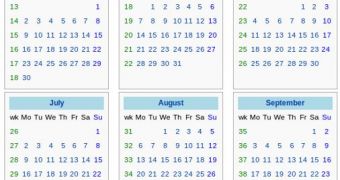Using a combination of mathematical formulas and advanced computer programs, researchers Richard Conn Henry and Steve H. Hanke recently developed a calendar that basically makes time stand still. The new way of organizing time will make each year identical to any other.
Henry is an astrophysicist at the Johns Hopkins University (JHU) Krieger School of Arts and Sciences, whereas Hanke is an applied economist at the Whiting School of Engineering, Science Blog reports.
The calendar they obtained after their rigorous research would ensure that each 12-month period is identical to the one that comes after it. What this means is that, if next year starts on a Sunday, then 2013, 2014, 2015 and all other years after it would also begin on Sunday.
Under the new Hanke-Henry Permanent Calendar, the number of days in several months would change. For example, September, March, June and December would all have 31 days, whereas the other 8 months will all have 30 days.
Needless to say, the old saying “30 days hath September, April, June and November” would no longer apply, and new rhymes would have to be developed. According to the experts, having access to a stable calendar would imply a number of benefits.
“Our plan offers a stable calendar that is absolutely identical from year to year and which allows the permanent, rational planning of annual activities, from school to work holidays,” Henry explains.
The expert also holds an appointment as the director of the Maryland Space Grant Consortium. He explains that the advantages of a stable calendar extend from birthday and holiday planning to improved economic performances.
“Think about how much time and effort are expended each year in redesigning the calendar of every single organization in the world and it becomes obvious that our calendar would make life much simpler and would have noteworthy benefits,” he adds.
According to Hanke, financial calculations would be simplified significantly. Determining the interest placed on mortgages, bonds, forward rate agreements and swaps will also be made easier, since the so-called rip off factor would be eliminated.
“Our current calendar is full of anomalies that have led to the establishment of a wide range of conventions that attempt to simplify interest calculations,” the JHU economist explains.
“Our proposed permanent calendar has a predictable 91-day quarterly pattern of two months of 30 days and a third month of 31 days, which does away with the need for artificial day count conventions,” he concludes.

 14 DAY TRIAL //
14 DAY TRIAL //